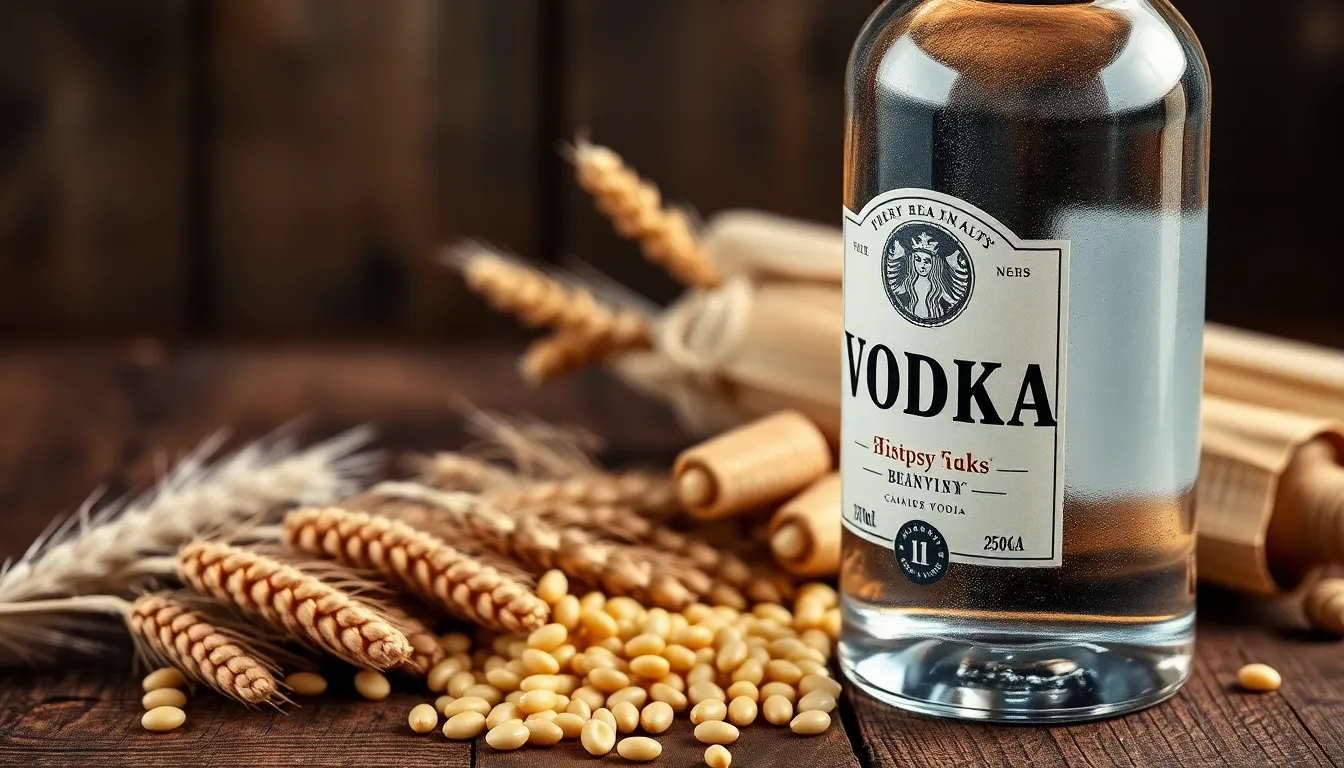Vodka, the beloved spirit that fuels countless parties and late-night adventures, often raises a burning question: does it contain sugar? For those watching their waistlines or counting carbs, this is no small matter. After all, nothing spoils a good buzz like an unexpected sugar crash.
Imagine sipping your favorite cocktail, blissfully unaware that it might be sneaking in some sugar. With vodka’s clean reputation, many assume it’s a guilt-free choice. But is that really the case? Whether you’re a vodka connoisseur or just someone trying to navigate the world of spirits, understanding what’s in your drink can make all the difference. So let’s dive into the sweet (or not-so-sweet) truth about vodka and sugar.
Table of Contents
ToggleUnderstanding Vodka
Vodka primarily consists of water and ethanol. Ingredients vary by brand but typically include grains such as wheat, rye, or corn. The fermentation and distillation processes result in a clear spirit with a high alcohol content, usually between 35% and 50%.
Many people believe vodka contains no sugar. This perception stems from its clean taste and reputation as a low-calorie beverage. Most reputable vodka brands label their products as sugar-free. Flavored vodkas, however, may include added sugars or sweeteners. These additives enhance taste, affecting overall sugar content.
The production method significantly influences vodka’s purity. High-quality vodkas undergo multiple distillations, removing impurities and residual sugars. Brands that utilize this process often emphasize their sugar-free status. It’s common for consumers to choose these options for health-conscious choices.
Reading labels can provide insight into sugar content. Distillers often disclose ingredients that help consumers make informed decisions. Certifications, such as gluten-free or organic, frequently accompany sugar-free labels, increasing transparency.
Monitoring sugar intake is essential for those following specific diets. Vodka generally aligns with low-carb and ketogenic regimens. Opting for plain vodka instead of sugary mixers can help maintain dietary goals. Adhering to moderation remains key in any alcohol consumption.
Ultimately, vodka’s sugar content largely depends on the type chosen. Selecting a plain, high-quality vodka minimizes sugar concerns. Exploring various brands and their labels allows for informed choices regarding sugar content.
Ingredients in Vodka

Vodka ingredients vary based on brand and type. Understanding these ingredients helps determine sugar content in the spirit.
Distillation Process
The distillation process significantly impacts vodka’s purity. Multiple distillations reduce impurities and help achieve a clean taste. Some brands emphasize their sugar-free status due to this meticulous process. High-quality vodka often undergoes filtration, further eliminating unwanted compounds. This attention to detail allows consumers to enjoy a spirit that aligns with low-sugar diets.
Common Ingredients
Common ingredients used in vodka include grains and potatoes. Many brands utilize wheat, rye, or corn as the base. These ingredients usually undergo fermentation and are distilled into ethanol. Potato vodka offers a distinct flavor profile, appealing to those seeking variety. While base ingredients do not inherently contain sugar, added flavors and sweeteners may contribute to sugar content in flavored vodkas. Hence, being mindful of ingredients can help consumers make informed choices.
Sugar Content in Vodka
Vodka typically contains very little to no sugar. Most brands keep their products sugar-free, appealing to health-conscious consumers.
Natural Sugar vs. Added Sugar
Natural sugars present in the base ingredients of vodka, such as grains or potatoes, remain minimal due to the fermentation and distillation processes. Distillation effectively removes most of these natural sugars, resulting in a spirit predominantly made up of ethanol and water. Added sugars, however, can vary significantly among flavored vodkas. Flavoring agents often introduce sweeteners or syrups, elevating sugar content above zero. Consumers should closely examine labels on flavored varieties to identify any added sugars.
Types of Vodka and Their Sugar Levels
Different vodka types exhibit varying sugar levels. Traditional vodka, made from grains or potatoes, generally maintains a sugar content of zero. Flavored vodkas, on the other hand, often contain added sugars to enhance taste. An example is vanilla or citrus-flavored vodka, which may contain sweeteners. Craft and artisanal brands might offer unique options and should be assessed for sugar content. Consumers focusing on health and diet should prioritize plain vodka to avoid excess sugars while enjoying their beverage choice.
Vodka Labels and Information
Understanding vodka labels is essential for making informed choices. Most vodka brands provide clear information regarding their ingredients and sugar content.
How to Read Labels
Reading labels on vodka bottles requires attention to detail. Consumers should look for terms like “sugar-free” or “no added sugars” prominently displayed. Distillation processes can also be mentioned, which indicates a brand’s commitment to purity. Ingredients usually follow a straightforward format, featuring base materials like wheat, rye, corn, or potatoes. Reading the nutritional information, if available, provides insights on calories and carbs. Unflavored varieties typically exhibit minimal to zero sugar content, making them popular among health-conscious drinkers. Familiarizing oneself with these terms ensures an informed decision.
Identifying Sugar-Free Options
Identifying sugar-free vodka options is straightforward with a few key tips. Check for labels that specify “sugar-free” or “no added sugars” to ensure the purity of the product. Classic vodka varieties made from grains or potatoes are usually safe bets for low sugar content. Flavored vodkas require extra scrutiny since they often include sweeteners or additives. Consumers can also explore brands known for their commitment to quality, as many reputable companies emphasize their sugar-free status. Craft and artisanal brands should be approached with caution, as their sugar content may vary. Making careful choices based on labels promotes a healthier experience without unnecessary sugars.
Vodka stands out as a low-sugar spirit when chosen wisely. Plain varieties typically contain little to no sugar, making them suitable for those mindful of their dietary choices. The distillation process plays a crucial role in maintaining vodka’s purity and low-calorie reputation.
However flavored vodkas can introduce added sugars and sweeteners, so consumers should carefully examine labels. By prioritizing high-quality, unflavored vodka, individuals can enjoy their drink without compromising their health goals. Understanding the ingredients and production methods ensures a more informed selection, allowing for a satisfying and guilt-free drinking experience.

